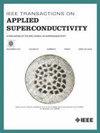AC Loss Characteristics of a Double Pancake Coil Wound With Multifilamentary REBCO Tape With High Inter-Filament Resistance
IF 1.7
3区 物理与天体物理
Q3 ENGINEERING, ELECTRICAL & ELECTRONIC
引用次数: 0
Abstract
Reducing AC loss in superconducting AC equipment is crucial because of its substantial contribution to the cryogenic load. Decreasing the filament width can mitigate hysteresis loss of REBa2Cu3O7−δ (REBCO, RE = rare earth elements) superconducting tapes, and segmenting the superconducting layer into multiple filaments is a viable reduction approach. However, filaments tend to connect when the inter-filament resistance is low. Therefore, we propose Cut and Aggregated Multifilamentary (CaAM) tapes with high inter-filament resistance achieved via the electrodeposition of polyimide across the entire tape. This tape configuration involves aligning four 1-mm-wide filaments in parallel and bonding them onto a polyimide substrate. AC loss measurements of short tapes exhibit a reduction at high magnetic fields. Additionally, we fabricated double pancake coils, each coil contained 80用具有高丝间电阻的多丝 REBCO 胶带绕制的双薄饼线圈的交流损耗特性
本文章由计算机程序翻译,如有差异,请以英文原文为准。
求助全文
约1分钟内获得全文
求助全文
来源期刊

IEEE Transactions on Applied Superconductivity
工程技术-工程:电子与电气
CiteScore
3.50
自引率
33.30%
发文量
650
审稿时长
2.3 months
期刊介绍:
IEEE Transactions on Applied Superconductivity (TAS) contains articles on the applications of superconductivity and other relevant technology. Electronic applications include analog and digital circuits employing thin films and active devices such as Josephson junctions. Large scale applications include magnets for power applications such as motors and generators, for magnetic resonance, for accelerators, and cable applications such as power transmission.
 求助内容:
求助内容: 应助结果提醒方式:
应助结果提醒方式:


